You are using an out of date browser. It may not display this or other websites correctly.
You should upgrade or use an alternative browser.
You should upgrade or use an alternative browser.
Ongoing Events in China
- Thread starter Jacques
- Start date
angelburst29
The Living Force
China will not tolerate attempts to separate Hong Kong from China: state media
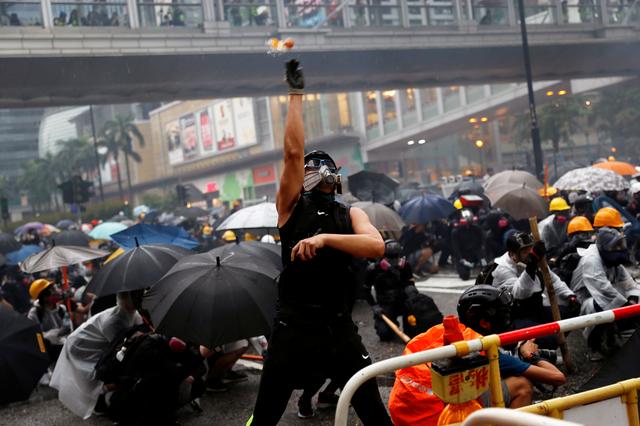
Hong Kong is an inseparable part of China and any form of secessionism "will be crushed", state media said on Monday, a day after demonstrators rallied at the U.S. consulate to ask for help in bringing democracy to city.
Hong Kong police fire tear gas as clashes erupt after thousands appeal to Trump
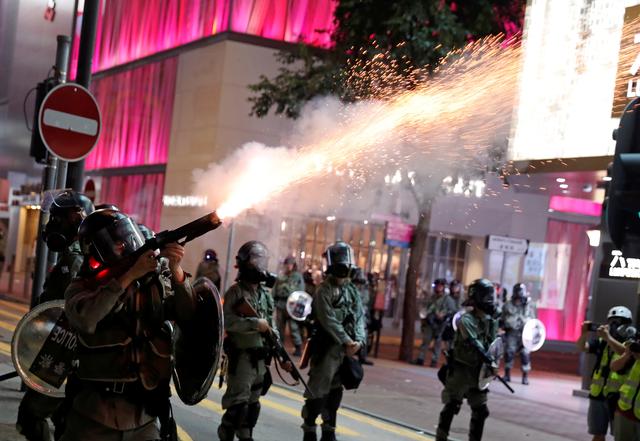
Hong Kong police fired tear gas to disperse protesters in the upmarket Causeway Bay shopping district on Sunday, after demonstrators had rallied at the U.S. Consulate calling for help in bringing democracy to the Chinese-ruled city.
Hong Kong August visitors plunge 40% year-on-year, hotels half-full: finance chief

Hong Kong visitor arrivals plunged nearly 40% in August from a year earlier, deepening from July's 5% fall, the finance secretary said as sometimes violent anti-government protests take a rising toll on the city's tourism, retail and hotel businesses.
Office provider The Executive Center pauses sale amid Hong Kong protests: source

Office space provider The Executive Center (TEC) has paused its sale process over fears that its large Hong Kong exposure could weigh on its valuation as sometimes violent protests continue in the city for a third month, according to a source.
Hong Kong is an inseparable part of China and any form of secessionism "will be crushed", state media said on Monday, a day after demonstrators rallied at the U.S. consulate to ask for help in bringing democracy to city.
Hong Kong police fire tear gas as clashes erupt after thousands appeal to Trump
Hong Kong police fired tear gas to disperse protesters in the upmarket Causeway Bay shopping district on Sunday, after demonstrators had rallied at the U.S. Consulate calling for help in bringing democracy to the Chinese-ruled city.
Hong Kong August visitors plunge 40% year-on-year, hotels half-full: finance chief
Hong Kong visitor arrivals plunged nearly 40% in August from a year earlier, deepening from July's 5% fall, the finance secretary said as sometimes violent anti-government protests take a rising toll on the city's tourism, retail and hotel businesses.
Office provider The Executive Center pauses sale amid Hong Kong protests: source
Office space provider The Executive Center (TEC) has paused its sale process over fears that its large Hong Kong exposure could weigh on its valuation as sometimes violent protests continue in the city for a third month, according to a source.
angelburst29
The Living Force
U.S. should side with Hong Kong protesters, says ex-Pentagon chief Mattis
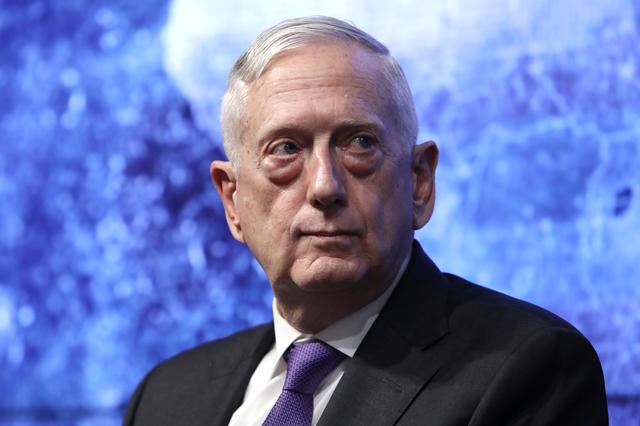
Former U.S. Secretary of Defense General Jim Mattis speaks at a Reuters Newsmaker event in New York, September 9, 2019. REUTERS/Gary He
Former U.S. Defense Secretary Jim Mattis said on Monday anti-government protests in Hong Kong were "not an internal" Chinese matter and that the United States should offer at least moral support to the demonstrators.
The retired U.S. Marine general, speaking at a Reuters Newsmaker event in New York, said the United States should generally side with those standing up for human rights, which he said included the Hong Kong protesters.
“When people stand up for those (rights), I just inherently think we ought to stand with them, even if it’s just moral,” said Mattis, who abruptly resigned as Pentagon chief in December over disagreements with President Donald Trump’s foreign policy.
“This is not an internal matter,” Mattis said in remarks likely to irritate Beijing, which has denounced the sometimes violent protests and accused the United States and Britain of fomenting unrest in the former British colony.
Trump has previously described the protests as riots, but has also called on China to end the discord in a “humanitarian” way. He said a crackdown could make his efforts to end a damaging trade war with China “very hard.”
Mattis said China’s effort to pass a law to allow people in Hong Kong to be extradited to mainland China was in breach of the “one country, two systems” formula under which British control of Hong Kong was ended in 1997.
“They said it would be two systems, and the extradition law was a violation of that,” said Mattis, who is promoting a new memoir about his role in the U.S. wars in Iraq and Afghanistan.
Although the extradition bill was withdrawn last week after months of unrest, the mass protests in streets and public places across Hong Kong continue, having grown into a broader pro-democracy backlash against the Chinese government.
Protesters marched outside the U.S. consulate in Hong Kong over the weekend, urging Trump to help “liberate” the city. Hong Kong police fired tear gas to disperse the crowds.
“We have to be careful: We don’t want to say we’re going to land the 82nd Airborne Division in Hong Kong to do this,” he said. “But morally? Yeah, I think we have to stand with them.”
Former U.S. Secretary of Defense General Jim Mattis speaks at a Reuters Newsmaker event in New York, September 9, 2019. REUTERS/Gary He
Former U.S. Defense Secretary Jim Mattis said on Monday anti-government protests in Hong Kong were "not an internal" Chinese matter and that the United States should offer at least moral support to the demonstrators.
The retired U.S. Marine general, speaking at a Reuters Newsmaker event in New York, said the United States should generally side with those standing up for human rights, which he said included the Hong Kong protesters.
“When people stand up for those (rights), I just inherently think we ought to stand with them, even if it’s just moral,” said Mattis, who abruptly resigned as Pentagon chief in December over disagreements with President Donald Trump’s foreign policy.
“This is not an internal matter,” Mattis said in remarks likely to irritate Beijing, which has denounced the sometimes violent protests and accused the United States and Britain of fomenting unrest in the former British colony.
Trump has previously described the protests as riots, but has also called on China to end the discord in a “humanitarian” way. He said a crackdown could make his efforts to end a damaging trade war with China “very hard.”
Mattis said China’s effort to pass a law to allow people in Hong Kong to be extradited to mainland China was in breach of the “one country, two systems” formula under which British control of Hong Kong was ended in 1997.
“They said it would be two systems, and the extradition law was a violation of that,” said Mattis, who is promoting a new memoir about his role in the U.S. wars in Iraq and Afghanistan.
Although the extradition bill was withdrawn last week after months of unrest, the mass protests in streets and public places across Hong Kong continue, having grown into a broader pro-democracy backlash against the Chinese government.
Protesters marched outside the U.S. consulate in Hong Kong over the weekend, urging Trump to help “liberate” the city. Hong Kong police fired tear gas to disperse the crowds.
“We have to be careful: We don’t want to say we’re going to land the 82nd Airborne Division in Hong Kong to do this,” he said. “But morally? Yeah, I think we have to stand with them.”
angelburst29
The Living Force
Timeline: Seven decades of Communist China

China will celebrate the 70th anniversary of Communist Party rule on Oct. 1 with flowers, speeches, performances and a massive military parade through central Beijing.
Ahead of huge parade, China complains of 'strange logic' about its military
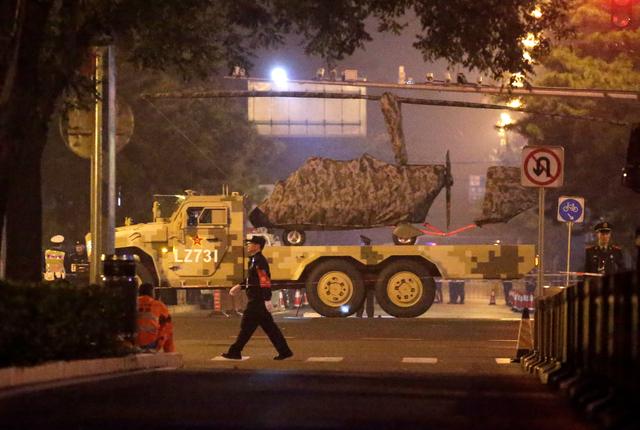
China's military complained on Tuesday that if it displayed new weapons at next week's huge military parade in Beijing it would be seen as a "show of force", and if it didn't then it would be blamed for a lack of transparency.
China needs strong leadership or will 'crumble,' policy paper says
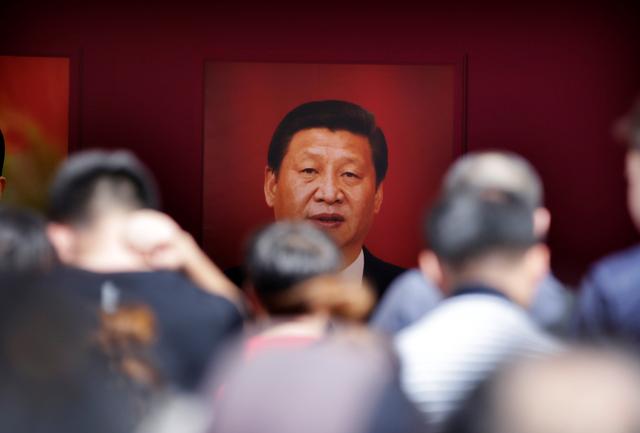
China needs the strong, unified leadership of the Communist Party or the country will "crumble," the government said in a policy paper released on Friday ahead of the 70th anniversary of the founding of the People's Republic.
China aims to join U.S.-spurned arms treaty as soon as possible
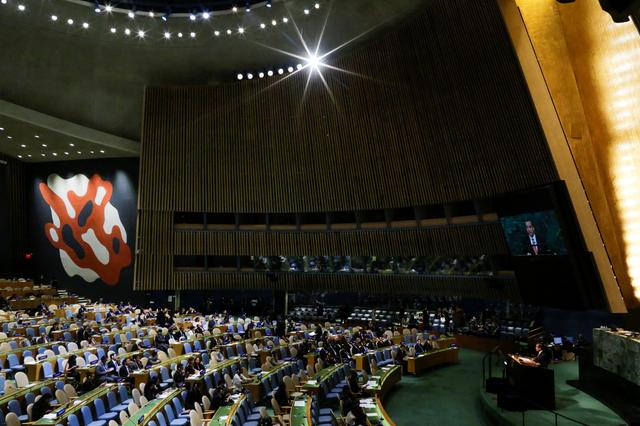
China wants to join as soon as possible an international arms treaty that the United States has spurned, the Foreign Ministry said on Saturday, adding it was China's responsibility to take part as a member of the international community.
Japan lists China as bigger threat than nuclear-armed North Korea

China's growing military might has replaced North Korean belligerence as the main security threat to Japan, Tokyo's annual defense review indicated on Thursday, despite signs that Pyongyang could have nuclear-tipped ballistic missiles.
Hong Kong protesters trap leader for hours in stadium after 'open dialogue'
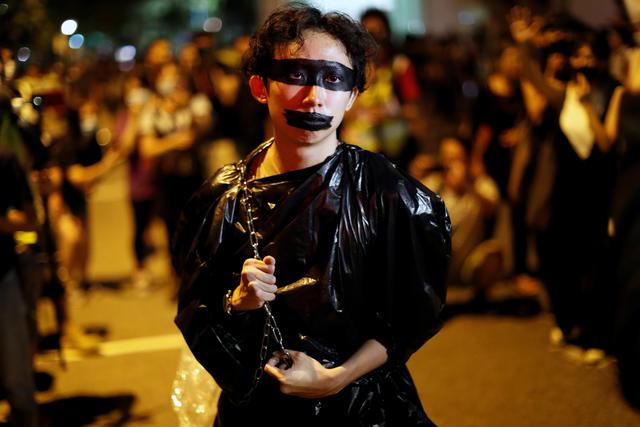
Hong Kong protesters chanting anti-government slogans trapped city leader Carrie Lam in a stadium for hours on Thursday after she held her first "open dialogue" with the people in a bid to end more than three months of often violent unrest.
Hong Kong's 'Umbrella' protests sowed seed for future: freed activist

Benny Tai, a leading Hong Kong activist who was jailed for his role in the 2014 pro-democracy "Umbrella" movement, says that campaign "revolutionized" youngsters and set the stage for the current protests on the streets of the China-ruled territory.
China will celebrate the 70th anniversary of Communist Party rule on Oct. 1 with flowers, speeches, performances and a massive military parade through central Beijing.
Ahead of huge parade, China complains of 'strange logic' about its military
China's military complained on Tuesday that if it displayed new weapons at next week's huge military parade in Beijing it would be seen as a "show of force", and if it didn't then it would be blamed for a lack of transparency.
China needs strong leadership or will 'crumble,' policy paper says
China needs the strong, unified leadership of the Communist Party or the country will "crumble," the government said in a policy paper released on Friday ahead of the 70th anniversary of the founding of the People's Republic.
China aims to join U.S.-spurned arms treaty as soon as possible
China wants to join as soon as possible an international arms treaty that the United States has spurned, the Foreign Ministry said on Saturday, adding it was China's responsibility to take part as a member of the international community.
Japan lists China as bigger threat than nuclear-armed North Korea
China's growing military might has replaced North Korean belligerence as the main security threat to Japan, Tokyo's annual defense review indicated on Thursday, despite signs that Pyongyang could have nuclear-tipped ballistic missiles.
Hong Kong protesters trap leader for hours in stadium after 'open dialogue'
Hong Kong protesters chanting anti-government slogans trapped city leader Carrie Lam in a stadium for hours on Thursday after she held her first "open dialogue" with the people in a bid to end more than three months of often violent unrest.
Hong Kong's 'Umbrella' protests sowed seed for future: freed activist
Benny Tai, a leading Hong Kong activist who was jailed for his role in the 2014 pro-democracy "Umbrella" movement, says that campaign "revolutionized" youngsters and set the stage for the current protests on the streets of the China-ruled territory.
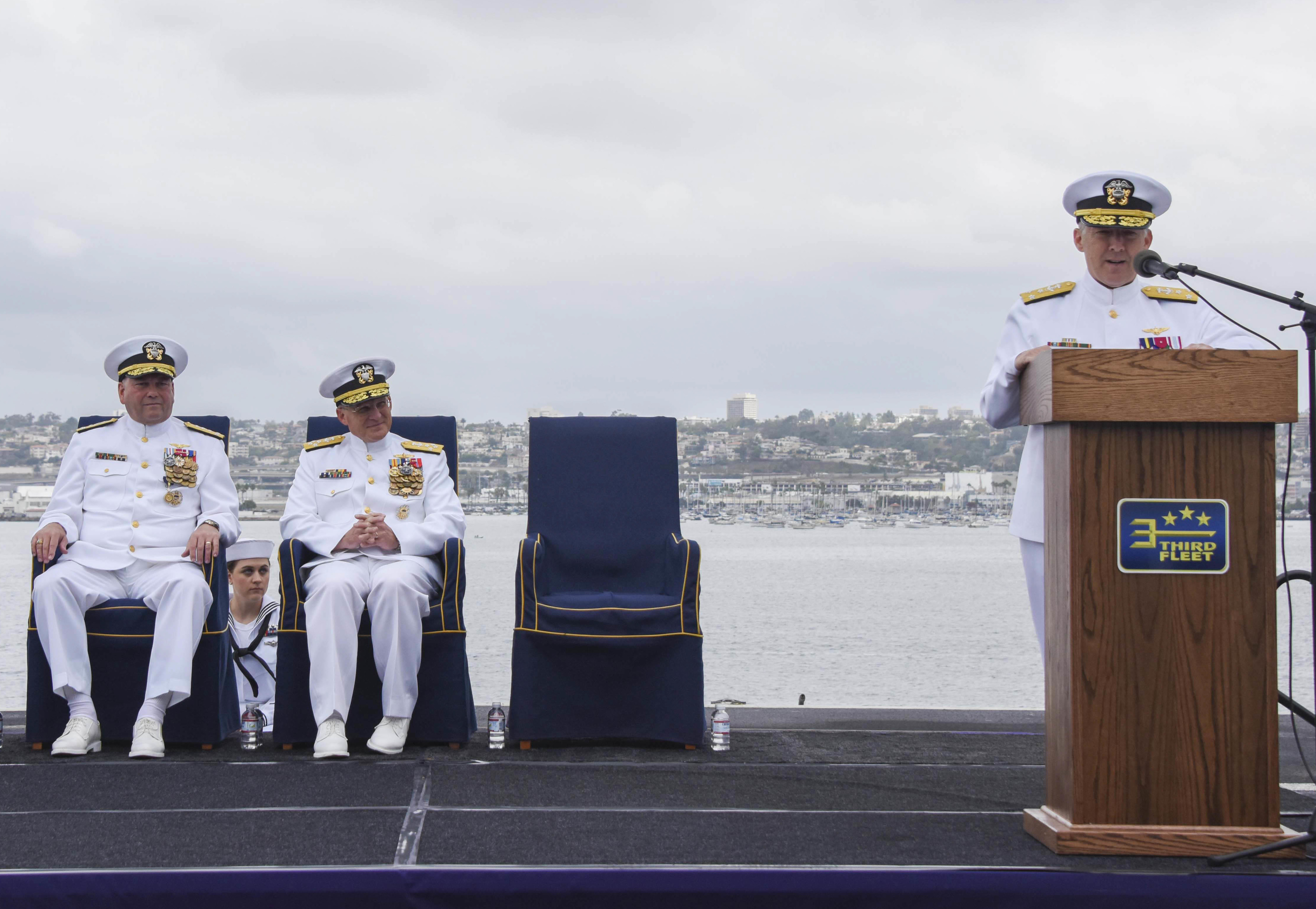
New 3rd Fleet CO Committed to Operating Forward to 'Preserve Peace' - USNI News
NAVAL BASE CORONADO, Calif. – The Navy’s West Coast-based fleet welcomed a new commander on Friday as Vice Adm. Scott “Satan” Conn took the helm of San Diego-based U.S. 3rd Fleet from Vice Adm. John D. “Sarge” Alexander. Chief of Naval Operations Adm. Mike Gilday, piled praise on Alexander, who...
September 27, 2019 9:13 PM
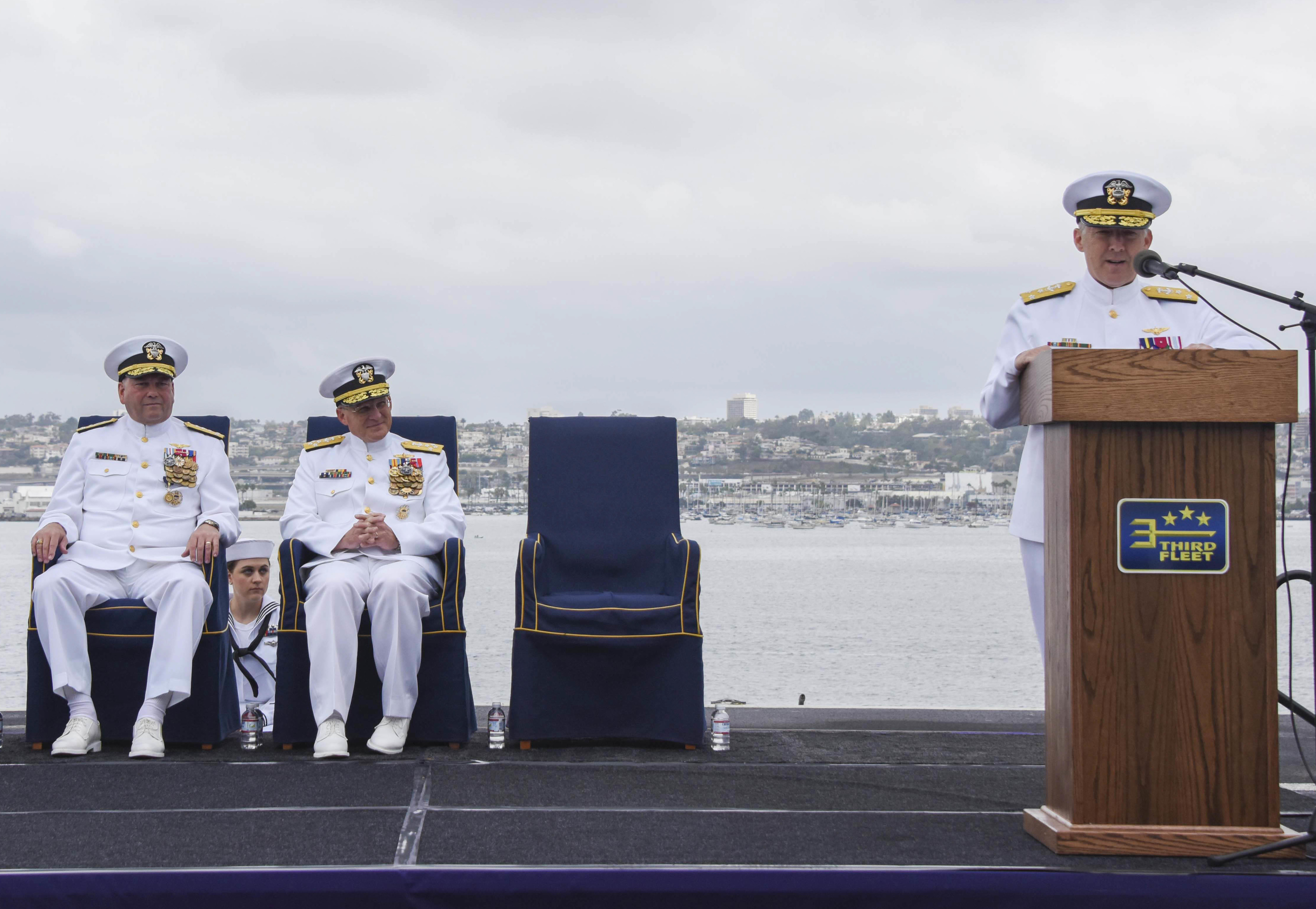
Vice Adm. Scott D. Conn delivers remarks during a change of command and retirement ceremony after relieving Vice Adm. John D. Alexander as Commander, U.S. 3rd Fleet, aboard Nimitz-class aircraft carrier USS Theodore Roosevelt (CVN-71) on Sept. 27, 2019. US Navy Photo
NAVAL BASE CORONADO, Calif. – The Navy’s West Coast-based fleet welcomed a new commander on Friday as Vice Adm. Scott “Satan” Conn took the helm of San Diego-based U.S. 3rd Fleet from Vice Adm. John D. “Sarge” Alexander.
Chief of Naval Operations Adm. Mike Gilday, piled praise on Alexander, who wrapped up a two-year tour leading 3rd Fleet through a transition to bolster the fleet’s maritime warfighting capabilities.
“His efforts to prepare our forces for a high-end fight… and sustain our ready force has focused the energies of a huge team towards maintaining a free and open Indo-Pacific,” Gilday said during the change-of-command ceremony, held under a haze-gray sky on the flight deck of the aircraft carrier USS Theodore Roosevelt (CVN-71).
“His high standards in certification and training ensured strike groups deployed from America’s West Coast performed at the absolute highest level,” Gilday told the crowd of several hundred. “And he was willing to think differently about the future security environment, pioneering annual operations in the Arctic in a way that we haven’t seen in a long, long time.” Those operations included Arctic Expeditionary Capabilities Exercise 2019 held this month in Alaska, the Aleutian Islands and Southern California.
Gilday, whose stop in San Diego came as he returned to Washington after visiting forces in Japan-based 7th Fleet, also noted Alexander’s role in leading the large, multilateral 2018 Rim-of-the-Pacific exercise and the certification for 3rd Fleet’s Maritime Operations Center “allowing tactical control forward when needed.”
Conn most recently served as the director of air warfare (N98) in the Office of the Chief of Naval Operations at the Pentagon. His leadership skills and experience from 34 years of service “make him exactly the right person to advance 3rd Fleet’s efforts even further,” Gilday said, noting that Conn’s most-recent assignment makes him “perfectly positioned to train our strike groups for employment at sea.” The CNO had promoted Conn to vice admiral earlier in the day.
“Scott is thinking differently about the future air wing and the human-machine integration that will be critical in any fight,” Gilday said, “and, as anybody knows, he’s not afraid to tell you what’s on his mind. We need candor and a clear-eyed approach to how we operate and fight.”
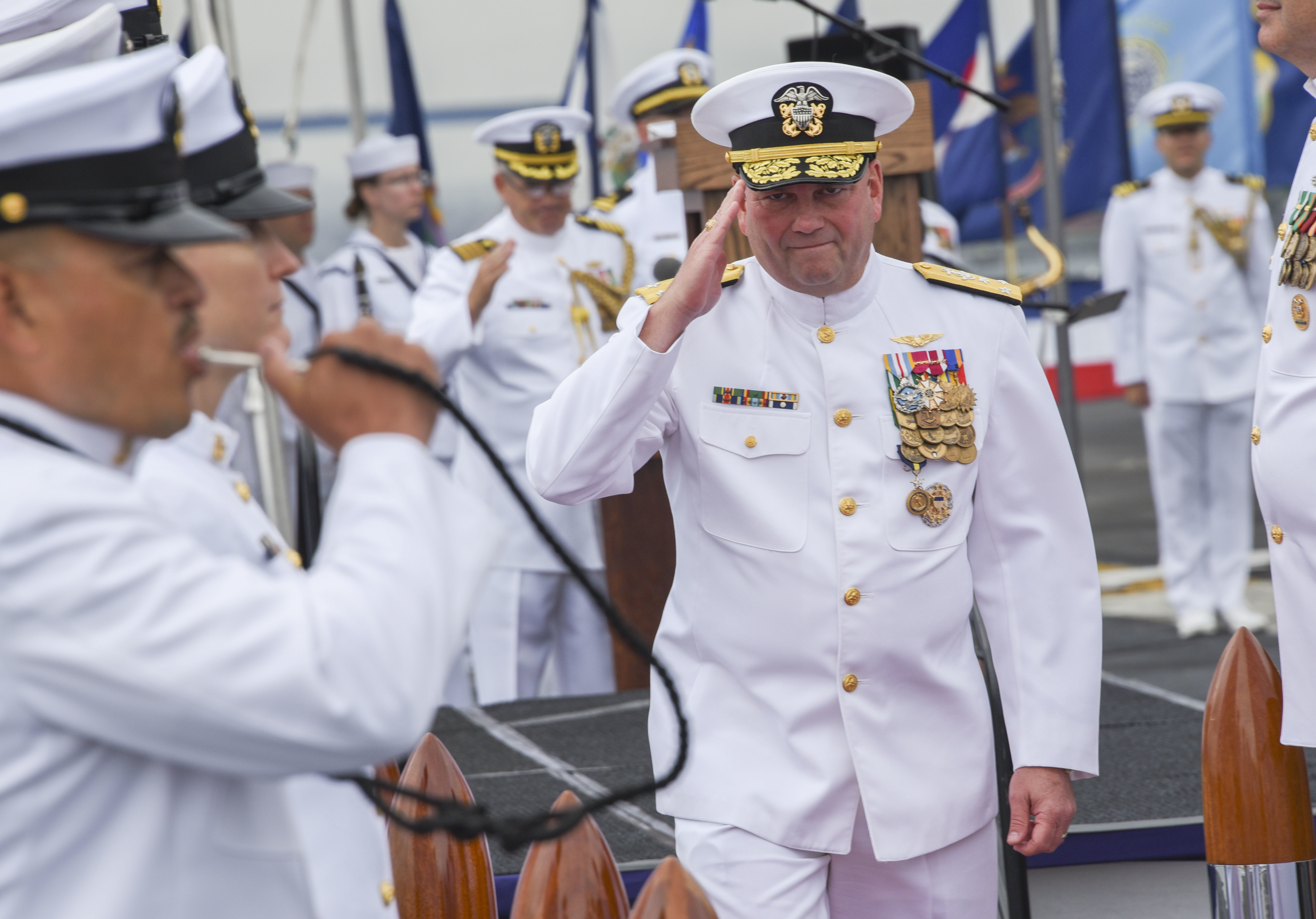
Vice Adm. John D. Alexander is piped ashore after relinquishing command of U.S. 3rd Fleet to Vice Adm. Scott D. Conn during a change of command and retirement ceremony aboard Nimitz-class aircraft carrier USS Theodore Roosevelt (CVN-71) on Sept. 27, 2019. US Navy Photo
“The strategic environment will only demand more from 3rd Fleet in the future,” he added.
Alexander, a former A-6E bombardier/navigator, is retiring from the Navy after a career that included tours in command of Electronic Attack Squadron 135, amphibious transport dock ship USS Juneau (LPD-10) and aircraft carrier USS Abraham Lincoln (CVN-72). Gilday presented Alexander with a Defense Distinguished Service Medal that recognized those contributions and his 37-year career.
Alexander took command of 3rd Fleet at a time when the Navy was transitioning to a more warfighting focus. But it’s role also is one deeply rooted, since the nation’s inception, in ensuring trade that has remained the life’s blood of the United States and its economy, he told the crowd. That role continues even as the Navy has evolved over the years to provide a force that the nation needed at the time, he added, noting he’s seen “four navies” during his career.
The Navy he joined and first deployed, in 1985, was a post-Vietnam, Cold War-era force built with 1950s-1960s technology and with 600,000 sailors and a nearly 600-ship fleet. “We rode that technology into Desert Storm, and systematically disassembled the fifth-largest military in the world in a matter of, literally, weeks,” he said. Then came the post-Cold War and 9/11 Navy that shifted to support combat operations in Afghanistan and, in 2003, in Iraq with new technologies but with 200,000 fewer personnel.
The decade after 2003 saw continued Navy downsizing of another 67,000 personnel, Alexander said, and “we created a disaggregated, ground-based posture to support our Navy’s counter-insurgency strategy in the Middle East.” With the creation of Navy Expeditionary Combatant Command and a riverine force, at one point the Navy had 34,000 sailors engaged on the ground or in the littorals, more than the Navy’s entire submarine force, he noted.
By 2014, Alexander said, the Navy was transitioning again, into the service he left today. “Russia had invaded the Crimea, and nobody did anything about that. China started pouring sand into the South China Sea,” he said, “and now we are seeing a resurgent Russia and a rising China, with China being our greatest long-term strategic threat. Through excessive territorial claims that trap diplomacy, militarization of disputed geographic features, China aims to control world trade and finance and politics and, ultimately, the way of life in Southeast Asia. So the stakes are high. We have a fundamental divergence of values with two incompatible visions for the future.
“Let there be no doubt: Great power competition is back, and we must maintain the technological edge as we go into the future.”
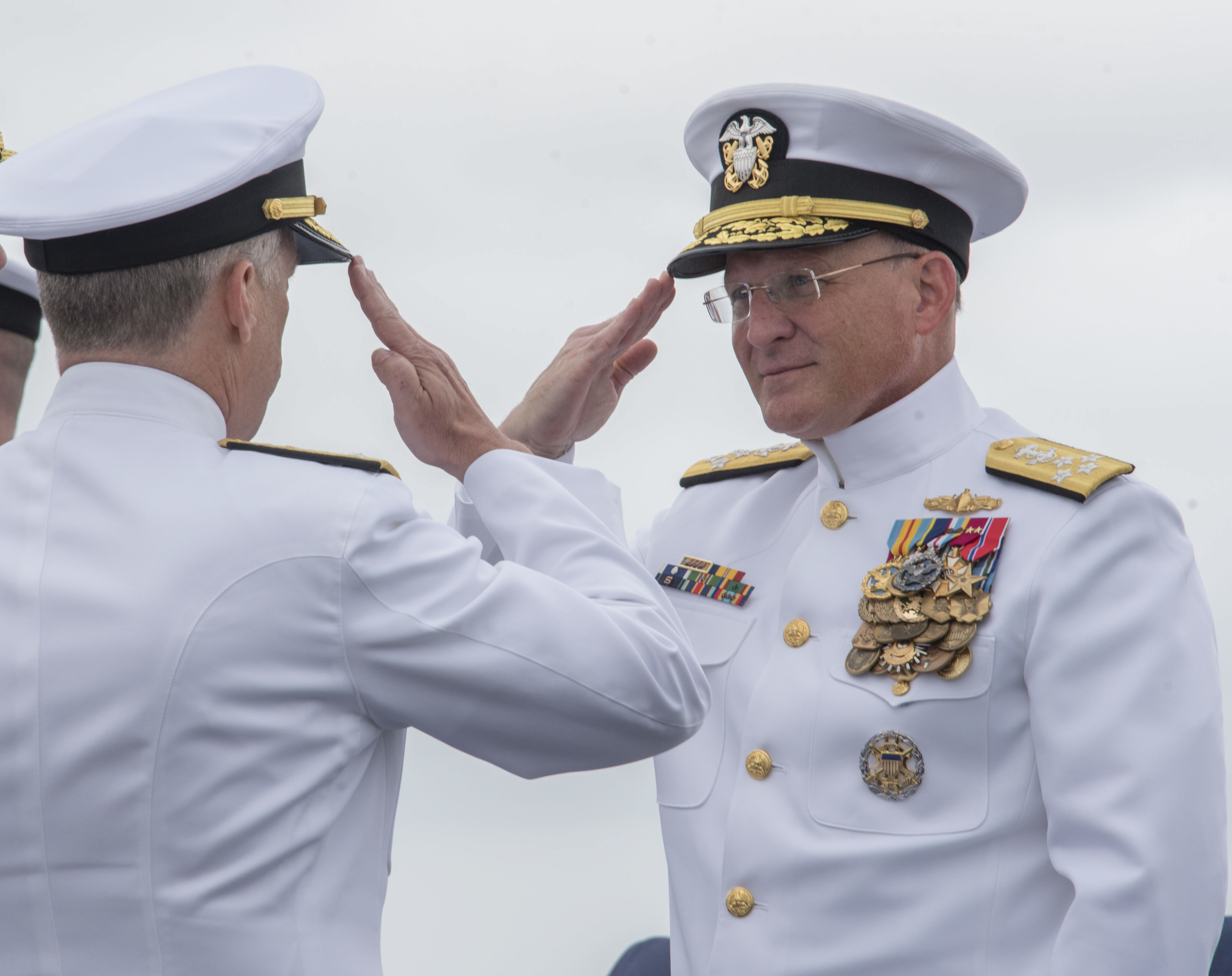
Vice Adm. Scott D. Conn salutes Chief of Naval Operations Adm. Michael M. Gilday (right) after receiving command of U.S. 3rd Fleet during a change of command and retirement ceremony aboard Nimitz-class aircraft carrier USS Theodore Roosevelt (CVN-71) Sept. 27, 2019. US Navy Photo
Alexander said the air wing of 1985 “looks nothing like what we have today,” with replacements of nearly all aircraft underway. The C-2 carrier onboard delivery airplane will be replaced by the MV-22 Osprey tiltrotor, he said, and the multi-mission, advanced F-35C Joint Strike Fighter will deploy aboard the aircraft carrier USS Nimitz (CVN-68) “later this coming year, bringing in a new age of lethality. It is that level of commitment that is necessary our dominance as a naval force across the globe.”
Conn, who became a naval aviator in 1987, has commanded Strike Fighter Squadron 136, Fleet Replacement Squadron 106, Carrier Air Wing 11, Naval Aviation Warfighting Development Center and Carrier Strike Group 4.
“Our first priority is to preserve peace by generating readiness of our equipment and our people to be able to employ forward as a deterrent first to anyone who should try to wish us harm,” he told the crowd. “And that is hard. But… in this environment, hard is authorized.”
“We will continue to build on the work” of Alexander’s tenure, he said, “and it’s up to the commanders to show results and to deliver those results.” Priorities include building partnerships, fostering trust and “being forward and being ready – day by day, night by night – on watch forward to preserve peace,” he added.
The military’s return to focus on high-end combat, with sustaining operations at sea against any adversary, mean “we must be ready to control the seas, the air, and deny any adversary the ability to threaten our homeland, our forces, our allies, our partners and our friends,” Conn said. He pledged to continue to “take a fully-certified Maritime Operations Center and make it expeditionary, capable of providing that one-two punch in conjunction with 7th Fleet.”
“We must continue to get better in all things we do. We will do so by continuing to operate outside our comfort zone… to challenge ourselves and challenge assumptions. We will send certified forces forward across the globe, and we will execute assigned missions professionally and boldly,” Conn said, adding,“we will work to uphold international rules and norms in the maritime domain, provide secure, safe and stable maritime environment and ensure continuing prosperity for all.”
Conn said he looks to continue to build and strengthen partnerships through multinational exercises like RIMPAC and the Oceania Maritime Security Initiative, adding, “we will strengthen each other by finding common ground while increasing our warfighting capability and capacity.”
“Our report card that will measure our success, he added, will be our ability to command and control integrated, distributed, disciplined and lethal combat fires at and from the sea that is synchronized with the joint force, at scale and with velocity. Our ability to maneuver to fire and fire to maneuver will be critical.”
angelburst29
The Living Force
NAVAL BASE CORONADO, Calif. – The Navy’s West Coast-based fleet welcomed a new commander on Friday as Vice Adm. Scott “Satan” Conn took the helm of San Diego-based U.S. 3rd Fleet from Vice Adm. John D. “Sarge” Alexander.
Thanks for sharing that article, C.a.!

Years ago, both of my Brother's were stationed at the Coronado Naval Base for a few months but on different ship's. From what they told me, it's a really big base. It was rare for their paths to cross, so to celebrate, they got a few of their buddies together and rented a fishing boat. Guess, they all had a great time because they still talk about it.
San Francisco tour guide charged with carrying U.S. secrets to China
A San Francisco tour guide has been charged with being an agent of the Chinese government, accused of picking up U.S. national security secrets from furtive locations and delivering them cloak and dagger style to Beijing, federal prosecutors said on Monday.
China to mark 70 years of communism with massive show of force in Beijing
China will celebrate seven decades of communist rule on Tuesday with a display of power through central Beijing, showing off goose-stepping troops, new missiles and floats celebrating the country's technological prowess.
Restive Hong Kong hunkers down as China's birthday celebrations begin
Hong Kong went into lockdown on Tuesday to ensure anti-government protests do not overshadow Chinese President Xi Jinping's commemorations of the 70th anniversary of the founding of the People's Republic of China.
'I love you China': Beijing enlists foreign voices ahead of anniversary
Chinese state media released videos of foreign citizens praising the country on the eve of celebrations to mark the 70th anniversary of the People's Republic, as new research showed declining perceptions of China in many western countries.
China to mark 70 years of communism with massive show of force in Beijing
Tweets on the Military hardware displayed on that 70th anniversary. Xi Jinping ...he ain't playing.
The lo exhaust of GJ-11, followed by loitering munitions.

Rioters set fires in central Hong Kong 暴徒在香港市中心縱火
DeepStateNews

The China Deception on This Week in Money
The mainstream are framing the rise of China as a competitor to the US in the same terms as they did the Cold War with the Soviet Union. And, just as the Cold War was a charade facilitated by lend lease and technology transfers, so, too, is the New Cold War facilitated by technology transfers to China that are framed as "IP theft." James Corbett joins Jim Goddard on This Week in Money to set the record straight on how the Clash of Civilizations 2.0 is being used to justify domestic clampdowns, social credit surveillance, and military build up.
Who benefits from Hong Kong protests?
Hong Kong is now in its ninth consecutive week of mass protests. The violent clashes between police and protesters have grabbed global attention. John Ross, former director of economic and business policy for the Mayor of London and a senior fellow at Chongyang Institute for Financial Studies under Renmin University of China, shares his views on the issue.
angelburst29
The Living Force
China says will work with the U.S. to address each other's core concerns
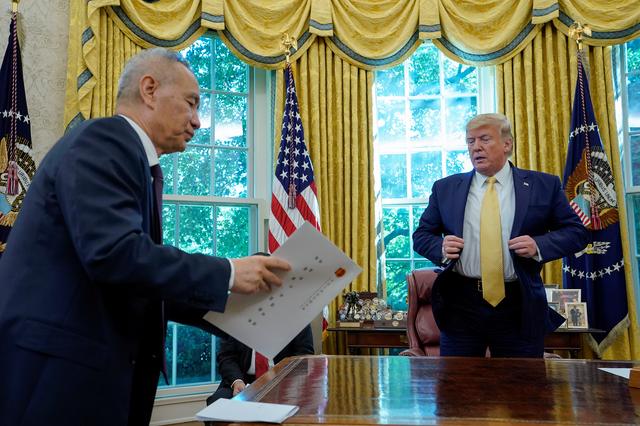
Chinese vice premier Liu He said on Saturday that China will work with the United States to address each other's core concerns on the basis of equality and mutual respect, and that stopping the trade war would be good for both sides and the world.
China stops couriers from shipping black clothing to Hong Kong amid protests

China has banned the bulk shipment to Hong Kong of black clothing and other gear used by pro-democracy protesters, staff at Chinese courier firms said, amid four months of often violent unrest in the city.
Home from home: Hong Kong police group plans retirement in mainland China

A Hong Kong police association is in talks with a Chinese property developer about a planned Hong Kong-themed retirement community in mainland China, it said on its website.
Hong Kong protesters vow to hit the streets in major 'illegal' march
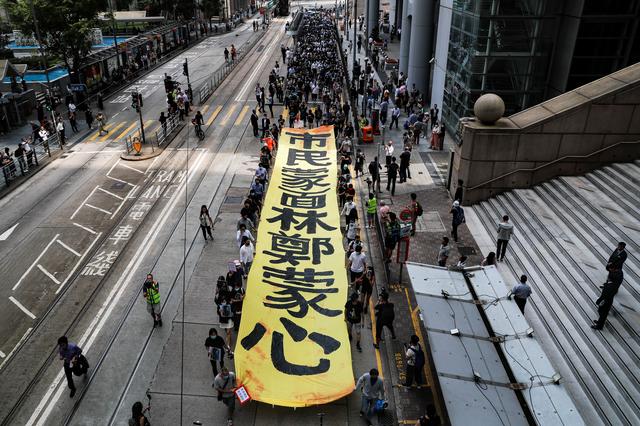
Hong Kong pro-democracy campaigners on Friday vowed to stage a major march at the weekend despite police ruling the rally illegal, setting the scene for possibly more unrest in the Chinese-ruled city, battered by months of violent protests.
Chinese vice premier Liu He said on Saturday that China will work with the United States to address each other's core concerns on the basis of equality and mutual respect, and that stopping the trade war would be good for both sides and the world.
China stops couriers from shipping black clothing to Hong Kong amid protests
China has banned the bulk shipment to Hong Kong of black clothing and other gear used by pro-democracy protesters, staff at Chinese courier firms said, amid four months of often violent unrest in the city.
Home from home: Hong Kong police group plans retirement in mainland China
A Hong Kong police association is in talks with a Chinese property developer about a planned Hong Kong-themed retirement community in mainland China, it said on its website.
Hong Kong protesters vow to hit the streets in major 'illegal' march
Hong Kong pro-democracy campaigners on Friday vowed to stage a major march at the weekend despite police ruling the rally illegal, setting the scene for possibly more unrest in the Chinese-ruled city, battered by months of violent protests.
angelburst29
The Living Force
I'm taking the position - of assuming why the Hong Kong protests have accelerated from a single peaceful protest - into weeks of further protests, violence and destruction? U.S. War-hawks are fueling the protests, hoping to create division between China and Hong Kong.
Pence tells Hong Kong protesters in China speech: 'We stand with you'
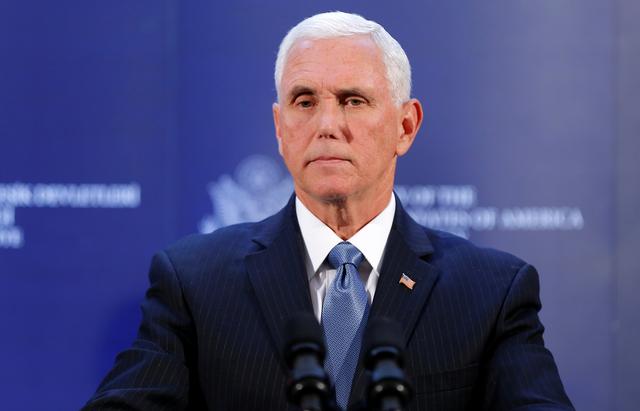
Vice President Mike Pence on Thursday accused China of curtailing "rights and liberties" in Hong Kong in a wide-ranging critique of Beijing's behavior but also insisted that the United States does not seek confrontation or to "de-couple" from its main economic rival.
Hong Kong pro-democracy protesters rally for Catalan separatists

Hundreds of Hong Kong protesters, some waving Catalan flags and banners urging "a fight for freedom together", rallied in support of a separate Catalonia on Thursday, broaching an issue that is anathema to Hong Kong's rulers in Beijing.
China has 'heavy heart' after 39 found dead in a truck in Britain
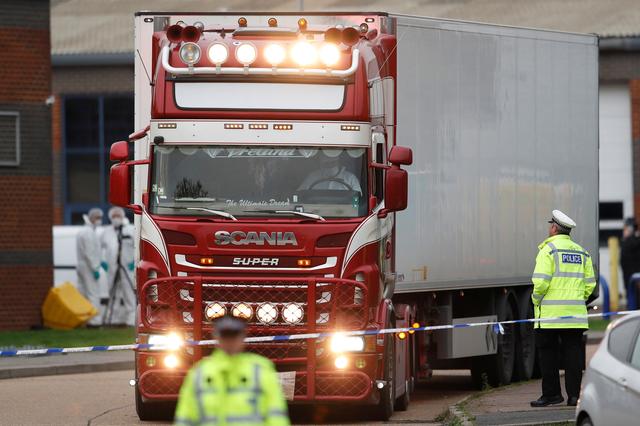
The Chinese embassy in London said on Thursday it had a heavy heart after reports that police had found 39 Chinese nationals dead in a truck.
UK police say 39 people found dead in truck near London were Chinese

All the 39 people found dead in a truck to the east of London are believed to be Chinese, British police said on Thursday, adding that raids had been carried out at three properties in Northern Ireland.
Ireland to investigate if truck where bodies found passed through country
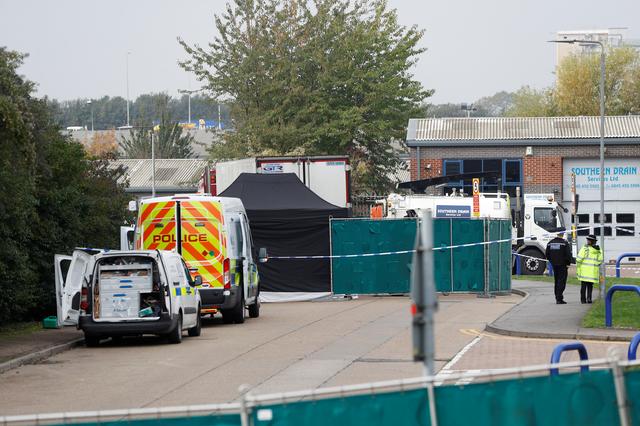
Irish authorities will carry out any investigations necessary if it is established that the truck in which the bodies of 39 people were found near London on Wednesday passed through Ireland, Prime Minister Leo Varadkar sa
China confirms reports that 39 dead in truck in U.K. are Chinese: Global Times
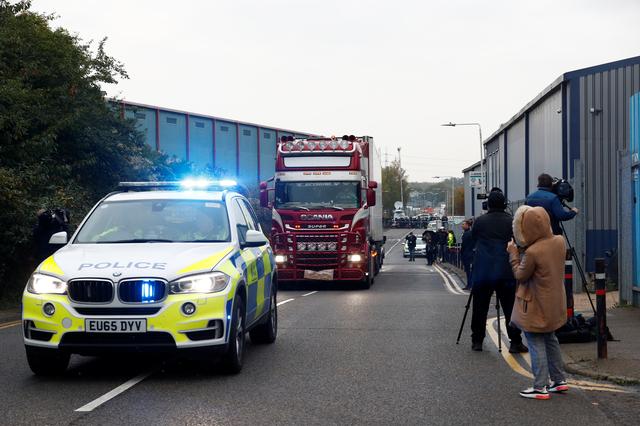
China's foreign ministry has confirmed reports that 39 people found dead in the back of a truck near London were Chinese, the Global Times said in a tweet on Wednesday.
Driver arrested after 39 found dead in truck near London
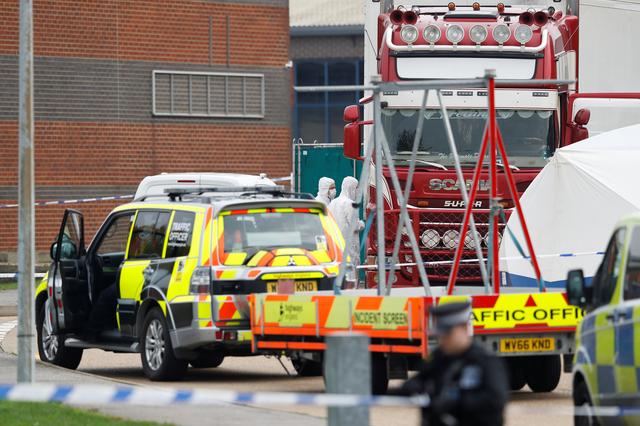
British police found the bodies of 39 people inside a truck at an industrial estate near London on Wednesday and said they had arrested the driver on suspicion of murder.
UK police believe trailer found with 39 bodies traveled from Belgium

British police said they believed the trailer from a truck found on Wednesday containing the bodies of 39 people had traveled from Zeebrugge, Belgium, into the port of Purfleet in eastern England.
Bulgaria has no link to truck death incident in UK: PM Borissov

The people found dead in a truck in Britain could not have boarded the vehicle in Bulgaria because it had not entered the country since its registration there in 2017, Bulgarian Prime Minister Boyko Borissov said on Wednesday.
Added note: The UK must be a transit point in the smuggling trade?
Police find nine people alive in back of truck in Kent, England: Sky News
Police in Kent, southeast England, found nine people alive in the back of a truck on the M20 motorway on Wednesday, Sky News reported.
Fire at steel mill in China's Hebei province kills seven
A fire at a steel producer in northern China's Hebei province has killed seven people, provincial authorities said on Thursday.
China says U.S. 'weaponizing' visas after space event no show

The United States is "weaponizing" visas, having failed to grant them in time or at all for Chinese space officials for an international event in Washington, China's Foreign Ministry said on Wednesday, in the latest escalation of tensions between the two countries.
Pence tells Hong Kong protesters in China speech: 'We stand with you'
Vice President Mike Pence on Thursday accused China of curtailing "rights and liberties" in Hong Kong in a wide-ranging critique of Beijing's behavior but also insisted that the United States does not seek confrontation or to "de-couple" from its main economic rival.
Hong Kong pro-democracy protesters rally for Catalan separatists
Hundreds of Hong Kong protesters, some waving Catalan flags and banners urging "a fight for freedom together", rallied in support of a separate Catalonia on Thursday, broaching an issue that is anathema to Hong Kong's rulers in Beijing.
China has 'heavy heart' after 39 found dead in a truck in Britain
The Chinese embassy in London said on Thursday it had a heavy heart after reports that police had found 39 Chinese nationals dead in a truck.
UK police say 39 people found dead in truck near London were Chinese
All the 39 people found dead in a truck to the east of London are believed to be Chinese, British police said on Thursday, adding that raids had been carried out at three properties in Northern Ireland.
Ireland to investigate if truck where bodies found passed through country
Irish authorities will carry out any investigations necessary if it is established that the truck in which the bodies of 39 people were found near London on Wednesday passed through Ireland, Prime Minister Leo Varadkar sa
China confirms reports that 39 dead in truck in U.K. are Chinese: Global Times
China's foreign ministry has confirmed reports that 39 people found dead in the back of a truck near London were Chinese, the Global Times said in a tweet on Wednesday.
Driver arrested after 39 found dead in truck near London
British police found the bodies of 39 people inside a truck at an industrial estate near London on Wednesday and said they had arrested the driver on suspicion of murder.
UK police believe trailer found with 39 bodies traveled from Belgium
British police said they believed the trailer from a truck found on Wednesday containing the bodies of 39 people had traveled from Zeebrugge, Belgium, into the port of Purfleet in eastern England.
Bulgaria has no link to truck death incident in UK: PM Borissov
The people found dead in a truck in Britain could not have boarded the vehicle in Bulgaria because it had not entered the country since its registration there in 2017, Bulgarian Prime Minister Boyko Borissov said on Wednesday.
Added note: The UK must be a transit point in the smuggling trade?
Police find nine people alive in back of truck in Kent, England: Sky News
Police in Kent, southeast England, found nine people alive in the back of a truck on the M20 motorway on Wednesday, Sky News reported.
Fire at steel mill in China's Hebei province kills seven
A fire at a steel producer in northern China's Hebei province has killed seven people, provincial authorities said on Thursday.
China says U.S. 'weaponizing' visas after space event no show
The United States is "weaponizing" visas, having failed to grant them in time or at all for Chinese space officials for an international event in Washington, China's Foreign Ministry said on Wednesday, in the latest escalation of tensions between the two countries.
The violence has all the hallmarks of ANTIFA. With the Deep States well organized Anti-China media campaign.
PBS: Oct 25, 2019 / 11:13
From Lebanon to Chile, economic uncertainty is driving a wave of protests
Graphic:

October 1, 2019
PBS: Oct 25, 2019 / 11:13
From Lebanon to Chile, economic uncertainty is driving a wave of protests
Graphic:

SOTTREADER
The Living Force
Posting this here to document an interesting view on China's operations in Africa. It does look like all the 'help' doesn't come for free, however, the outcome is not set in stone. In a spirit of mutual efforts, the video alludes to the chinese expecting the local african governments to get their acts together in order to repay their loans. Sadly, the video doesn't touch on the interest arrangements of said loans as this I believe tends to be the main killer (together with corruption from the region)
In any case, interesting view
To get away from the african-centric posts, here is another interesting take on China and Russia's relationship around the arctic region. It would seem the two are bound by mutual interests but this doesn't negate having areas of friction and distrust.
In any case, interesting view
To get away from the african-centric posts, here is another interesting take on China and Russia's relationship around the arctic region. It would seem the two are bound by mutual interests but this doesn't negate having areas of friction and distrust.
The disinformation is working overtime, and promoting fear mongering.
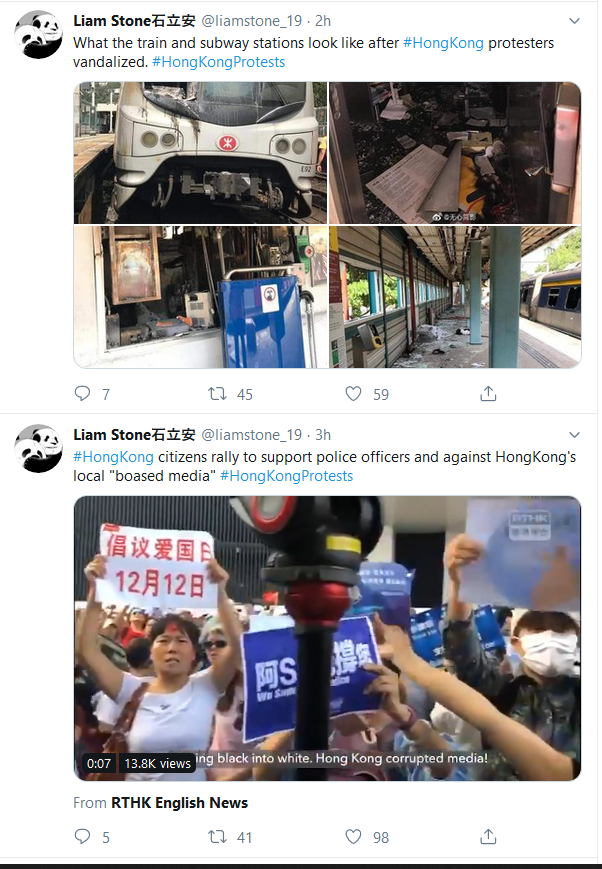
"Catapultes, flèches enflammées" : A Hong Kong, le mouvement se durcit
"Catapults, fire arrows": In Hong Kong, the movement hardens
FRANCE 24 Nov 15, 2019
#Chinese Embassy says after two #Australian MPs were denied entry into China.
6:11 AM · Nov 17, 2019 CGTNOfficial
Cnn
A 23-year-old protester and Polytechnic University alumni told CNN that they didn't have a plan and were just waiting to see how the police would react. "If we don't come out, no one will come out and protect our freedoms. Polytechnic University is my home," he said.
On Sunday the government announced that all schools would be shut again on Monday as protests were expected to continue across the city.

"Catapultes, flèches enflammées" : A Hong Kong, le mouvement se durcit
"Catapults, fire arrows": In Hong Kong, the movement hardens
FRANCE 24 Nov 15, 2019
#Chinese Embassy says after two #Australian MPs were denied entry into China.
6:11 AM · Nov 17, 2019 CGTNOfficial
"Chinese people do not welcome those who make unwarranted attacks, wantonly exert pressure on China, challenge China's sovereignty, disrespect China's dignity and undermine mutual trust,"
Last edited:
I thought this was interesting. The fascists from Ukraine are 'tourists' in Hong Kong. Not so surprising as they had the same sponsors. One could compare these professional 'activists' with professional mercenaries. It is their profession and they do what their paymasters wants them to do.

 sputniknews.com
sputniknews.com
Why Are Ukrainian Neo-Nazis Joining the Hong Kong Protests?

22:47 02.12.2019
Prominent Ukrainian neo-Nazi figures have been spotted in the Hong Kong protests just weeks after hosting an “academy of street protest” in Kiev.
Leaders of far-right Ukrainian groups that rose to prominence in the 2014 coup d’etat they helped orchestrate, including the Azov Battalion and Right Sektor, have recently traveled to Hong Kong to participate in the anti-Beijing protests there. It’s unclear why the groups, sporting the apparel of a far-right hooligan group called “Honor” or “Gonor,” have gone to Hong Kong, but the fact that both the 2014 Ukrainian coup and the present protests in Hong Kong have enjoyed extensive support from the CIA-spawned National Endowment for Democracy may give a clue.
“Fight for freedom stand with Hong Kong!!” said another post by Filimonov, showing them posing, masked, alongside Hong Kong protesters.
Figures in the video as well as photos posted the following day include Ihor Maliar, an Azov Battalion veteran who sports a “victory or Valhalla” tattoo across his neck, and Serhii Sternenko, who headed the Odessa section of Right Sektor when it torched the Trade Unions House on May 2, 2014, killing 42 people and injuring hundreds in the street violence before and after. Sternenko also helped found the “People's Lustration” fascist gang, which harassed, beat up and humiliated former officials of the Ukrainian government in the months following the 2014 Euromaidan coup.

© SPUTNIK SCREENSHOT
Screenshot of a Facebook post by Serhii Filimonov showing "Gonor" members in Hong Kong
Several of the men wear paraphernalia of the far-right “Honor” or “Gonor” so-called youth group founded by Filimonov in 2015, sporting a stylized version of the “trident,” a symbol with ancient meaning in Ukraine adopted by ultra-nationalists, as three daggers. Several also have neo-Nazi tattoos, such as swastikas.
The men also posed in front of the wrecked Hong Kong Polytechnic University, where an intense two-week showdown between police and protesters saw more than 1,000 students detained and thousands of weapons seized, including petrol bombs and explosives.

© SPUTNIK SCREENSHOT
Serhii Filimonov post showing Ukrainian far-right figures posing in front of Hong Kong Polytechnic University
Early last month, Filimonov, Sternenko and Maliar spoke at an “academy of street protest” in Kiev, the posters of which featured a molotov cocktail emblazoned with the “Gonor” logo.

© SPUTNIK SCREENSHOT
Poster for an "academy of street protest" featuring lectures by several Ukrainian far-right figures
A Ukrainian Facebook page that came to the defense of the Gonor crew and their trip Monday afternoon seems to bridge the gap between the two movements. Calling itself the “Free Hong Kong Center,” the page posts about the supposed strong links between the Hong Kong and 2014 Ukraine protests, complete with the words “umbrella” and “dignity” on their banner, referencing what demonstrators in Hong Kong called their 2014 protests, seen as a precursor to the present unrest, and by far-right Ukrainians to the 2014 coup.

© SPUTNIK SCREENSHOT
Facebook post by "Free Hong Kong Center" defending "Gonor" members' visit to Hong Kong
It’s not clear exactly what these “simple activists” were doing in Hong Kong. However, it’s worth noting the extensive groundwork laid for both the 2014 uprising in Ukraine and the 2019 protests in Hong Kong via the National Endowment for Democracy (NED).
By Morgan Artyukhina

Why Are Ukrainian Neo-Nazis Joining the Hong Kong Protests?
Prominent Ukrainian neo-Nazi figures have been spotted in the Hong Kong protests just weeks after hosting an “academy of street protest” in Kiev.
Why Are Ukrainian Neo-Nazis Joining the Hong Kong Protests?

22:47 02.12.2019
Prominent Ukrainian neo-Nazi figures have been spotted in the Hong Kong protests just weeks after hosting an “academy of street protest” in Kiev.
Leaders of far-right Ukrainian groups that rose to prominence in the 2014 coup d’etat they helped orchestrate, including the Azov Battalion and Right Sektor, have recently traveled to Hong Kong to participate in the anti-Beijing protests there. It’s unclear why the groups, sporting the apparel of a far-right hooligan group called “Honor” or “Gonor,” have gone to Hong Kong, but the fact that both the 2014 Ukrainian coup and the present protests in Hong Kong have enjoyed extensive support from the CIA-spawned National Endowment for Democracy may give a clue.
“Hong Kong welcomed us as relatives,” Serhii Filimonov wrote on Facebook Saturday, sharing a video of himself and other Ukrainian far-right figures in the semi-autonomous Chinese city. Filimonov once headed the Kiev branch of the Azov Civilian Corps, a support group for the ultra-nationalist Azov Battalion that’s thinly veiled as a civilian NGO.
“Fight for freedom stand with Hong Kong!!” said another post by Filimonov, showing them posing, masked, alongside Hong Kong protesters.
Figures in the video as well as photos posted the following day include Ihor Maliar, an Azov Battalion veteran who sports a “victory or Valhalla” tattoo across his neck, and Serhii Sternenko, who headed the Odessa section of Right Sektor when it torched the Trade Unions House on May 2, 2014, killing 42 people and injuring hundreds in the street violence before and after. Sternenko also helped found the “People's Lustration” fascist gang, which harassed, beat up and humiliated former officials of the Ukrainian government in the months following the 2014 Euromaidan coup.

© SPUTNIK SCREENSHOT
Screenshot of a Facebook post by Serhii Filimonov showing "Gonor" members in Hong Kong
Several of the men wear paraphernalia of the far-right “Honor” or “Gonor” so-called youth group founded by Filimonov in 2015, sporting a stylized version of the “trident,” a symbol with ancient meaning in Ukraine adopted by ultra-nationalists, as three daggers. Several also have neo-Nazi tattoos, such as swastikas.
The men also posed in front of the wrecked Hong Kong Polytechnic University, where an intense two-week showdown between police and protesters saw more than 1,000 students detained and thousands of weapons seized, including petrol bombs and explosives.

© SPUTNIK SCREENSHOT
Serhii Filimonov post showing Ukrainian far-right figures posing in front of Hong Kong Polytechnic University
Early last month, Filimonov, Sternenko and Maliar spoke at an “academy of street protest” in Kiev, the posters of which featured a molotov cocktail emblazoned with the “Gonor” logo.

© SPUTNIK SCREENSHOT
Poster for an "academy of street protest" featuring lectures by several Ukrainian far-right figures
A Ukrainian Facebook page that came to the defense of the Gonor crew and their trip Monday afternoon seems to bridge the gap between the two movements. Calling itself the “Free Hong Kong Center,” the page posts about the supposed strong links between the Hong Kong and 2014 Ukraine protests, complete with the words “umbrella” and “dignity” on their banner, referencing what demonstrators in Hong Kong called their 2014 protests, seen as a precursor to the present unrest, and by far-right Ukrainians to the 2014 coup.
“They assured us they are really against nazism and another kind of alt-right ideology,” they posted, dismissing the neo-Nazi imagery as traditional Ukrainian symbols.The Center came to the defense of Gonor on Monday, posting that they are “simple activists” now and “are not connected to any Azov movements any more.”

© SPUTNIK SCREENSHOT
Facebook post by "Free Hong Kong Center" defending "Gonor" members' visit to Hong Kong
It’s not clear exactly what these “simple activists” were doing in Hong Kong. However, it’s worth noting the extensive groundwork laid for both the 2014 uprising in Ukraine and the 2019 protests in Hong Kong via the National Endowment for Democracy (NED).
Whether Filimonov and associates are there at the NED’s behest or as simply a bit of protest tourism is anybody’s guess.In the three years before the 2014 coup, the CIA-backed NED sunk $14 million into regime change efforts in Ukraine, and the NED has been cultivating anti-Beijing attitudes in Hong Kong since the mid-1990s, before the territory was returned to Chinese rule by the British Empire.
By Morgan Artyukhina
Trending content
-
Thread 'Coronavirus Pandemic: Apocalypse Now! Or exaggerated scare story?'
- wanderingthomas
Replies: 30K -
-
